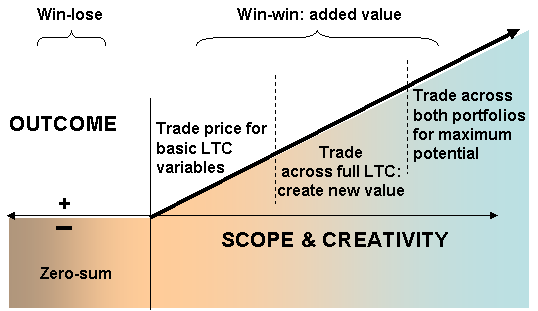This is the third and final in a series of articles on commercial negotiation of long term energy contracts, written by Nick Perry.
In the first two parts of this series we looked at how out-of-the-money long term energy contracts (LTCs) give rise to commercial tensions. We considered how these can either degenerate into wasteful commercial conflict or, more constructively, act as a catalyst for win-win renegotiations. We also considered the scope for creativity in recasting the contract across several of its many dimensions, allowing the distressed party to trade for some relief against its main source of financial pain, and enabling both sides to avoid the uncertain outcome of arbitration or the courts.
In this final article of the series, we extend this lateral thinking even more widely, to look at opportunities for commercial tradeoffs at a portfolio level.
Broadening the scope
We have already observed that by their very nature, LTCs are complex and multi-dimensional. This provides fertile ground for creative commercial thinking and, in particular, for win-win opportunities to be found. These often arise as a result of asymmetries in the positions of the two parties: their respective costs of capital; their assessments of extrinsic value; their tax positions; their varying abilities to manage risks; their trading capabilities etc.
In the same vein, it is usually the case that the parties to large energy LTCs are companies with extensive portfolios. These often range widely across regional energy sectors (utilities with generating fleets, gas assets and infrastructure investments) or international markets (oil and gas players with widespread interests), or indeed both.
Leveraging the portfolio
Large companies rarely see themselves as static: they generally have strategic goals that include transition over time away from, say, one traditional class of assets or geographical location towards another. Their counterparty in an LTC may very probably have assets that could be of interest to them in their longer-term objectives: and in the 21st century most assets ‘have their price’.
Open-minded consideration of the two portfolios across the negotiating table may reveal useful differences in valuation – be that cash or strategic value – that can be traded on, in exactly the same way as terms within the LTC but on an even larger and more fruitful scale as illustrated in Diagram 1.
The key requirements to turn this from a theoretical prescription into a practical source of significant value are several:
- Creative and experienced negotiators, deal structurers and advisers
- A comprehensive and flexible analytical capability to identify and value opportunities
- Open-minded corporate management, willing to consider creative solutions
Companies should resource negotiations appropriately to the amount of value at stake. These can be among the largest sums that will ever be contested across their negotiating tables.
Companies that know the score
The energy companies that are probably most familiar with this approach are E&P players in the oil and gas sector. They often have very different legacy portfolios specialities. For example, one may have an exploration bias, a US market orientation, and strongly prefer gas assets over oil; another may have offshore specialities, its own refineries, and favour already-producing oil plays in developing markets.
Their risk management precepts also place value on portfolio diversification; and they are well-versed in joint ventures, ‘farming-in’ and ‘farming out’ assets. Asset swaps are a familiar feature of their commercial repertoire. For such companies, their non-core assets are always potentially ‘in play’, and can serve to add a depth of possibilities to a commercial forum that was initiated by the need to renegotiate an LTC.
Examples of the portfolio approach
Companies from other traditions do well to emulate this open-minded commercial approach, and some have done this successfully. Good examples include:
- E.ON, which has exchanged European downstream positions and midstream assets with Gazprom in exchange for upstream assets in Russia
- BASF, which has packaged gas LTCs with assets and marketing ventures in deals also with Gazprom
Perhaps the most comprehensive example of a successful portfolio approach to solving distressed LTCs is that of the former British Gas Corporation (BGC), and its offshoot Centrica in its first years of existence after de-merger from BGC in the mid 1990s. At that time BGC was in a classic LTC squeeze, having over-bought gas in a series of GSAs at prices that were many billions of pounds out-of-the-money after the UK gas price collapse of 1994-5.
In order to give its corporate restructuring the best chance of success, BGC and later Centrica entered a series of difficult renegotiations with the key gas producing companies that were the counterparties to their GSAs. They were prepared to consider any contractual structure, and indeed settled on a wide range of different solutions. Some deals were bought out for cash; some with changes to the detailed terms of the GSAs; and others involved assets from BGCs own portfolio of UKCS assets.
In less than 2 years they negotiated out the most economically damaging prices in their portfolio under more than a dozen LTCs – a very commendable timetable, given how long some LTC counterparties take to renegotiate a single GSA. (For completeness it should be noted that the UK government made clear to all the parties concerned that they were expected to make constructive progress in these sessions, and itself contributed expeditious treatment of the several complex tax issues involved.)
Negotiating with perspective
Out-of-the-money LTCs can be a source of substantial damage to energy companies, with severely out of the money contracts sometimes proving fatal. Attempts to re-negotiate contracts can be extremely fraught. Too often a one-dimensional, zero-sum, win-lose approach is taken to contract negotiation. But a creative commercial approach that is allowed to range over as wide an area as possible – within the LTC itself and sometimes even more widely across the portfolio – can identify win-win opportunities that facilitate better outcomes for both parties.

